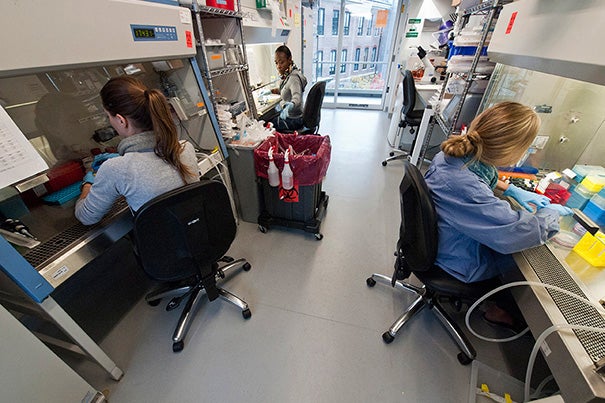
The Sherman Fairchild Building is a LEED Platinum-certified building. In its first year, Fairchild achieved a 24 percent reduction in energy use, a notable accomplishment for an energy-intensive laboratory.
File photo by B. D. Colen/Harvard Staff
Progress on sustainability
University acts on accountability to the future, announces next steps
Harvard University has made significant progress in reducing its greenhouse gas emissions, according to a report released today by President Drew Faust, who announced the next steps that the institution will take to meet its goal of cutting emissions 30 percent by 2016.
“When we determined six years ago to reduce our carbon footprint, I firmly believed that Harvard had a responsibility to model an institutional pathway toward a more sustainable future,” said Faust. “I am extremely proud of the way we have come together as ‘One Harvard’ to seek a pathway to a more sustainable future.”
In 2008, the University committed to the ambitious goal of reducing greenhouse gas emissions 30 percent, relative to its 2006 baseline, by 2016. According to the latest data, efforts by students, faculty, and staff have already achieved a reduction of 21 percent, when the effects of growth are included, or 31 percent, excluding growth.
In order to hit the 30 percent mark inclusive of growth, Faust outlined a series of steps designed to drive the University closer to its goal over the next two years. “As we recognize our progress,” she said, “we must also recommit to the work ahead.”
Faust approved the recommendations of a 2012-2013 faculty, student, and staff task force that performed a quadrennial review of Harvard’s progress on cutting emissions.
The task force’s report recommended continuing to explore and exhaust all efforts on campus efficiency and reduction projects to the extent possible, and establishing a committee of senior-level faculty to shape the next generation of sustainability solutions and strategy on campus.
The task force also found that, as anticipated in 2008, even after all feasible and cost-effective, on-campus energy efficiency projects have been exhausted, a gap will likely remain to achieve a 30 percent reduction. The task force recommended establishing an advisory committee to evaluate and recommend off-campus greenhouse gas reduction options that could include offsets, investments in renewable energy, and other complementary mechanisms, added to the steps the University has already taken.
“Our objective all along has been to create an economically viable and replicable example for how large institutions can reduce emissions and save money,” said Executive Vice President Katie Lapp. “We have been focused on building a sustainable community that not only supports but strengthens Harvard’s research and teaching mission.”
An executive committee co-chaired by Lapp, Jeremy Bloxham, dean of science and Mallinckrodt Professor of Geophysics in the Faculty of Arts and Sciences (FAS), and Robert S. Kaplan, senior associate dean and professor of management practice at Harvard Business School (HBS), has been responsible for overseeing greenhouse gas reduction efforts. In 2008, under the leadership of the executive committee, the Office for Sustainability developed a University-wide implementation strategy to pursue emissions reductions that was informed by the deliberations of five working groups representing hundreds of stakeholders across Harvard.
“Harvard’s greenhouse gas reduction goal has been a model for leadership, about having the courage as a university to articulate a clear vision for our role in the world, and then developing a comprehensive action plan for how to break down siloes and align the community around that vision,” said Kaplan.
According to Heather Henriksen, director of the Office for Sustainability, progress to date has been achieved by focusing on five key areas and developing an unprecedented level of collaboration among Harvard’s Schools and administrative departments. “It all comes down to the dedication and hard work of thousands across our campus who are committed to changing the culture of how we work and live,” said Henriksen.
Energy and emissions planning, tracking and implementation
To maximize energy-efficiency opportunities, planning on that score was integrated into the five-year capital planning process, and all Schools performed expansive energy audits in their buildings. A greenhouse gas emissions inventory was created to track and report on emissions across all Harvard facilities on the continent.
Facilities teams have been implementing cost-effective efficiency projects across their building portfolios, and as a result more than 1,300 energy conservation measures have been implemented. Increasingly, building managers are focusing on a process called commissioning to further reduce energy by optimizing building energy systems and performance. Projects teams have also been targeting one of the biggest challenges for reducing emissions: the expansion of energy-intensive laboratory and high-performance computing space necessary to meet cutting-edge research needs.
“Our research needs in laboratories and computing are energy intensive, but the responsibility belongs to all of us,” said Bloxham. “With projects like the Massachusetts Green High Performance Computing Center and an ongoing commissioning projects at the LISE and Northwest buildings that has delivered millions in savings, we are focused on developing the most energy-efficient, sustainable research practices possible.”
Transitioning to a cleaner energy supply
Switching from oil to cleaner-burning natural gas at the Harvard-owned Blackstone Steam Plant by Campus Services has contributed 28 percent of the emissions reductions necessary to meet the greenhouse gas reduction goal. Upgrades to outdated boilers and the addition of a cogeneration unit to turn waste heat into electricity have further reduced emissions. In addition, 17 percent of Harvard’s electricity comes from renewable energy sources, and thousands of solar photovoltaic panels have been installed, generating more than a megawatt of electricity.
Policies and tools to drive change
University-wide tools and resources have helped facilities teams break down barriers and pursue projects that deliver a positive rate of return. A $12 million Green Revolving Fund has supported more than 200 energy-related projects that have yielded more than $5.4 million in energy savings annually. Green building standards establish a process ensuring that clear sustainability goals are set early to maximize results and ensure that capital projects incorporate long-term results and costs into decision-making. A “life cycle cost policy,” tailored to Harvard-specific utility rates, is used to evaluate new technology and upgrades based on cost-effectiveness and environmental benefit.
“I care deeply about our commitment to sustainability, including bringing together HBS’s various departments monthly to assess our progress, and I am proud of what our team has accomplished,” said Angela Crispi, associate dean for administration and senior executive officer of Harvard Business School (HBS). “These efforts have a wide ripple effect, not only in serving as a model others can learn from but also in influencing students, faculty, staff, and alumni to think about what improvements they can make in their personal and professional lives.”
Engaging students in creating solutions is also an important piece of the puzzle. Since 2010, a Student Sustainability Grant program has funded 45 student projects that reduce energy or contribute to the University’s sustainability goals.
“The grant program has encouraged me to look at the bigger picture, shaping my own thoughts of what I want the sustainable future to look like and how we can get there,” said Abhinav Bhushan, a research fellow at Harvard Medical School and Massachusetts General Hospital who received a grant this year to organize a “sustainability hackathon” on April 19. “The hackathon will bring together a diversity of viewpoints to generate several ideas for sustainable living that could, at the very least, result in student-entrepreneurs-led startups or be picked up as model projects for further investigation.”
Organizational alignment
University-wide committees involve senior administrators, including facilities and operations teams, student leaders, and faculty advisors, in policy development so that everyone has a voice in how decisions are made and everyone is accountable for results.
Education and outreach campaigns to bring about culture change have engaged and motivated the broader University community to contribute to reducing energy and resource use. Another focus has been integrating sustainability into established business practices at central administrative departments. Last year, Harvard Human Resources and the President’s Office, for the first time, recognized nine “green heroes” as part of its Harvard Heroes employee recognition program.
Integrating research and teaching with on-campus challenges
Increasingly, the Office of Sustainability and other organizations are seeking to connect classrooms with on-campus challenges. For many years, students in the ES96 Engineering Design Seminar have helped to develop solutions to complex campus energy problems, including a 2011 analysis that supported expansion of a geothermal heating and cooling system to serve a second building at the Radcliffe Institute for Advanced Study.
Environmental health doctoral candidates and Jack Spengler, Akira Yamaguchi Professor of Environmental Health and Human Habitation at the Harvard School of Public Health, have integrated undergraduate river Houses into a National Science Foundation-funded study looking at environmental factors that influence comfort, health, and sleep in buildings. Working with the undergraduate resource efficiency program, the research team has collected environmental samples from more than 80 rooms and surveyed more than 250 students in three river Houses.
Building on this progress will require a renewed effort to push the boundaries of energy efficiency and new technologies, according to Rebecca Henderson, John and Natty McArthur University Professor and co-director of the Business and Environment Initiative at HBS.
“The good news is that organizations all over the world, including Harvard, are finding that committing to greenhouse gas reduction is triggering a wave of creativity, engagement, and innovation that is leading to very significant progress,” said Henderson. “Transitioning to a less energy-intensive future makes smart business sense, and I have no doubt that our University community will continue to make truly extraordinary progress on this front.”
Beyond emissions reductions, the creation of a University-wide sustainability plan, currently under way, will acknowledge the University’s progress in building a more-sustainable community and will identify a clear operational strategy aimed at reducing environmental impact and promoting a healthy campus community.
“The greenhouse gas reduction (GHG) goal was envisioned to be a catalyzing force for the University community, setting near-term targets on the way to a long-term goal of emission reductions needed to moderate the likelihood of dangerous climate change,” said William Clark, Harvey Brooks Professor of International Science, Public Policy and Human Development, who chaired the 2008 task force that set the goal.
“The next evolution of Harvard’s efforts must be to continue our progress on GHG, while at the same time defining a more comprehensive approach that will align our campus with the best-in-class sustainability science and innovation being conducted globally,” he added. “This will mean focusing on measures that improve the well-being of people in Harvard’s immediate community and those we affect, including continuing efforts to reduce our impact on the environment, accelerated efforts to enhance the health of our community, and efforts to advance knowledge in shaping sustainable development.”




